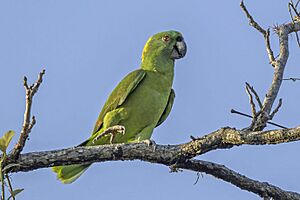Yellow-naped amazon facts for kids
Quick facts for kids Yellow-naped amazon |
|
|---|---|
 |
|
| Suchitepéquez Department, Guatemala | |
| Conservation status | |
| Scientific classification | |
| Genus: |
Amazona
|
| Species: |
auropalliata
|
| Synonyms | |
|
Amazona ochrocephala auropalliata |
|
The yellow-naped amazon or yellow-naped parrot (Amazona auropalliata) is a beautiful green parrot. You can find it along the Pacific coast of southern Mexico and Central America. It's easy to spot with the bright yellow band on the back of its neck!
Sadly, this amazing bird is now considered Critically Endangered. This means its population has dropped by more than 92% in just the last three generations. The main reasons for this big drop are deforestation (losing their forest homes) and the illegal removal of young parrots for the pet trade.
These parrots are very popular as pets because they can learn to copy sounds. This includes human speech! However, just like people, some parrots are better at talking than others. Even with their declining numbers, the population in Costa Rica is still the largest.
Contents
What Does the Yellow-Naped Amazon Look Like?
The yellow-naped amazon is mostly green. It has a green forehead and the top of its head. A bright yellow band crosses the lower part of its neck. Its eyes are orange, and its beak is dark gray. The beak becomes lighter towards the top. Its feet are also dark gray.
Where Do Yellow-Naped Amazons Live?
Yellow-naped amazons live in dry forests and mangrove swamps. These are warm, tropical places. They make their nests in natural holes in trees. They don't dig the holes themselves. But they might chew the entrance to make it bigger. They nest in many types of trees. Dead palm trees, called Coyols, are a favorite spot.
During the breeding season, pairs stay together. They defend a small area around their nest. They do this by singing together with their partner. It's like a special song just for their territory!
How Do Yellow-Naped Amazons Communicate?
Scientists have studied how yellow-naped amazons talk more than any other wild parrot. These parrots learn their calls from each other. This means their calls change in different areas. It's similar to how humans have different languages or dialects. These different calls are important to the parrots. They respond less to calls that are not from their own area. These special calls also stay the same for a long time.
Mated pairs of yellow-naped amazons also sing together. They make very complex and coordinated songs. These songs follow certain rules. The order of notes can change in flexible ways. Neighboring pairs of birds will also sing back and forth. This is called "counter-duetting." Sometimes, these singing contests can get intense. But physical fights are rare.
Types of Yellow-Naped Amazons
There are three different types, or subspecies, of the yellow-naped amazon:
- A. a. auropalliata: This type lives from southern Mexico to northwestern Costa Rica.
- A. a. parvipes: You can find this one in the Mosquito Coast. This is in eastern Honduras and northeastern Nicaragua.
- A. a. caribaea: This type lives on the Bay Islands, Honduras.
Yellow-Naped Amazon's Diet
Like many parrots, the yellow-naped amazon eats different plant foods. They enjoy eating nuts, berries, seeds, and fruit.
Yellow-Naped Amazons as Pets
Yellow-naped amazons are popular pets. People like them for their talking ability and playful personalities. However, they can be very protective of their nests. This can sometimes lead them to bite. This is more common with males during breeding season.
These parrots show when they are stressed or too excited. They will spread their tail feathers. They also do something called "eye pinning." This is when their eye pupils get bigger and smaller quickly. If you let them calm down before handling them, bites are not common. Like many parrots, they often bond very closely with one person in a home. They might get a bit jealous of others.
Yellow-naped amazons love to interact with people. The more they are around humans and other animals, the more comfortable they become. In the wild, they chew on wood to make their nests. So, as pets, they need safe toys to chew on. They also enjoy playing with objects.
There is a very rare blue version of the yellow-naped amazon. Its whole body is a beautiful turquoise color!
Images for kids







